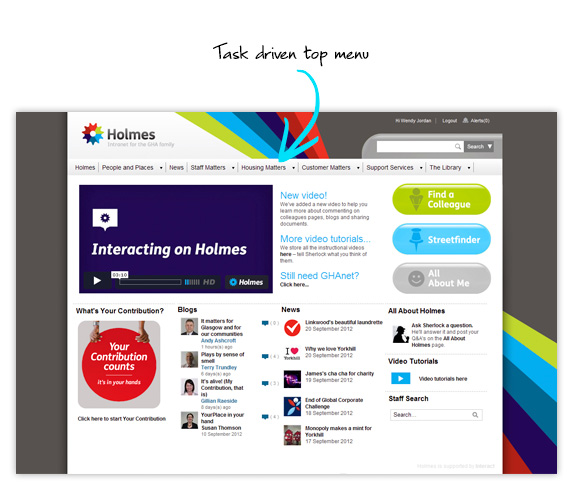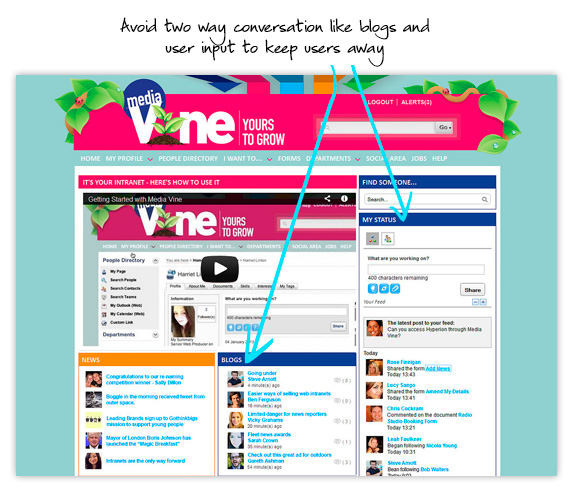There are probably a million ways you can lose a user from your intranet and some will be particular to your company, but we think these are top 10 that you really need pay to attention to:
1. Don’t give users the right tools
The first thing you should do if you don’t want employees’ using your intranet is to not give them the right tools. If they haven’t got the right technology they will not be able to access your content as frequently as they would with access to a device in their everyday work. Don’t kid yourself that your company information is so engaging that they will voluntarily read it on their own time.
When planning your intranet, really take some time to understand your users; who are they and where do they work? Desk based or out of the office? What kind of technology have they got? PC’s, laptops, tablets or smartphones? Can they access your intranet on that device? Have they got the right software installed like flash and soundcards for video and a PDF reader for those attachments and uploaded documents? Interact Intranet recognises that more and more companies are embracing remote and flexible working and the rise of working with tablets and smartphones. Interact Intranet 7’s seamless view gives users the same experience regardless whether users are on a PC, hand held or smart phone.
2. Have an intranet with no purpose
What are you trying to achieve with you intranet? There has to be solid reasons for people to visit your intranet and view the content. Without understanding what your users want and need from your intranet and providing solutions, your users have no reason to visit. Thinking that just switching your intranet on will solve all of your company’s communication problems is a mistake; it has to solve a problem or make work easier or quicker.
Easy access to holiday forms and claiming expenses are reasons that users will visit your intranet, when you get them there you can pull them in and then communicate your corporate messages to them.
Tools like the Absence Manager are a good way to pull users into your intranet to complete an important admin task.
3. Make your intranet difficult to navigate
A good search engine is not a license to ignore intuitive, task based navigation. If you make your intranet really complicated to navigate, it is harder to cross-promote information to users. An intranet is not like a commercial website where people are happy to browse around to find what they are looking for; intranet users want to get in, get the information they need and get out. If it’s too complicated to find the information they need they will give up. Don’t take them through a maze: take them straight to the content they want. A good way to do this is by the use of task driven architecture, for example a top menu which supports the way users work.

4. Don’t bother updating content
Out of date content sends a really clear message to your users: nobody cares about this intranet. And if the company doesn’t care about the intranet why would the user care about it or bother coming back to it? Fresh content is the bedrock of a successful intranet; seeing the same news article or promoted content time and time again will not inspire your users to have confidence that the rest of your documents are relevant and up to date.
5. Use free text everywhere
The bane of any intranet is free text, especially the “ Welcome to …” sections that are so commonly seen. Do not litter your valuable intranet real estate above the fold with free text. Remember, people want the information they need quickly so use your content pages to give it to them. Use tools like Interact Analytics to assess the most commonly used content for each area and place this above the fold.
6. No user input or two-way communication
How many times have you heard (or said…) this:
“We really want people to discuss things on the intranet, we would really like to get people blogging”.
You and your stakeholder group may be saying this, but are you and they taking part in the conversation? We work in linear companies and people follow their leaders; so the people at the top need to get the trend started, sparking conversations. Think of it like a fire; you need a spark, kindling and some oxygen to get it going. Then once it’s lit the flames will spread and all you have to do is throw on the odd log! Leaders need to show their staff that its ok to post opinions online by taking the lead and inviting others to comment.

7. Make it all about ‘The Management’
Your users are not as interested in your corporate messages as you would like them to be. It is your job to get them interested, by making it engaging. Wanting your intranet to be the primary centre of all your communications is a noble desire for your intranet but in reality we see so often that this is usually a bi-product of your intranet. Getting users to trust and like your intranet builds the basis for a platform where communicating corporate news is effective. So don’t make your intranet all about ‘The Management’ and corporate messages and nothing else; it is not the best way to engage employees with your intranet.
Forums that offer users an opportunity to discuss topics that matter to them are a great way to get your people to see your intranet as a place to make connections with colleagues. Social connections and shared interests form a great basis for work connections.
8. Make content irrelevant to users
Most people work in fairly diverse environments with different departments, locations and job functions. What one user needs may be of no relevance to someone else. Interact Intranet allows each user to have a unique home page based on their working profile, relevant to their job and what they want to see. Your analytics will tell a story about what users from each department or location are accessing on a regular basis and can help you refine their intranet experience over time.
9. Don’t provide any help
You should always have an up to date library of how to guides or training videos and a clear way for people to ask questions and get answers about using the intranet. The intranet is always going to be new for someone after all. At launch, a full suite of drop in sessions and how to guides should be available, which then get worked into your company induction.

10. Never evolve your intranet
If you don’t want to keep your users coming back, don’t evolve your intranet. When launching, consider the pros and cons of a big launch versus a drip fed ‘long wow’. The latter allows you to stagger the release and promotion of functionality and content that may prevent a spike of usage followed by a period of stagnation.
In both cases, you should have a plan of how you want the intranet to evolve. Revisit your initial objectives and decide where you want your intranet to go in the next week, month and quarter. Have a success plan to get where you want to be. You don’t have to have everything from day one, as it will risk bamboozling your customers. In both cases you should have a content plan showing what content is being uploaded to the intranet and what information you need to promote on the front page.
(Source: http://www.interact-intranet.com/10-ways-to-lose-your-intranet-users/?utm_source=Blog&utm_medium=twitter&utm_campaign=10losers)